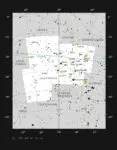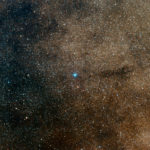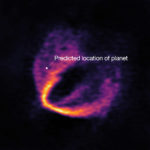ALMA Discovers Trio of Infant Planets around Newborn Star
12 June, 2018 / Read time: 9 minutes
Scientific PaperTwo independent teams of astronomers have used Atacama Large Millimeter/submillimeter Array (ALMA) to uncover convincing evidence that three young planets are in orbit around the infant star HD 163296. Using a novel planet-finding technique, the astronomers identified three disturbances in the gas-filled disc around the young star: the most reliable evidence yet that newly formed planets are in orbit there. These are considered the first planets discovered by ALMA.
ALMA has transformed our understanding of protoplanetary discs — the gas- and dust-filled planet factories that encircle young stars. The rings and gaps in these discs provide intriguing circumstantial evidence for the presence of protoplanets [1]. Other phenomena, however, could also account for these tantalizing features.
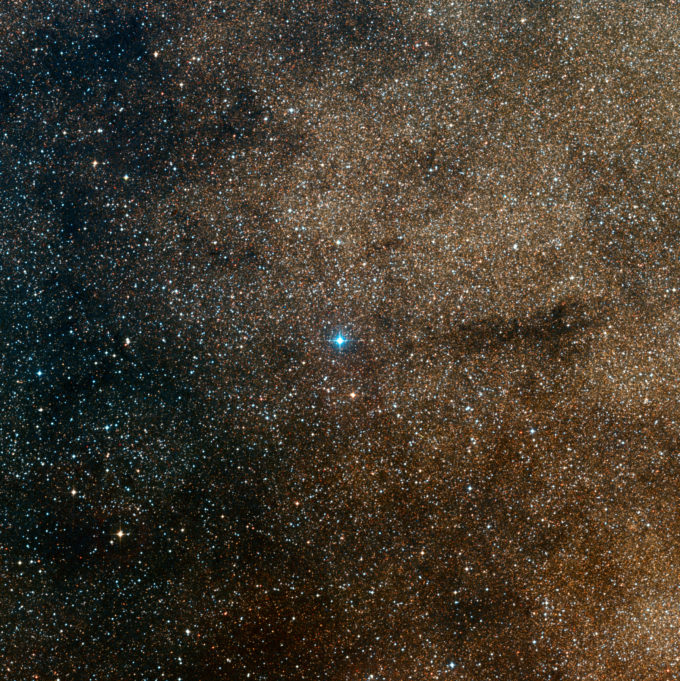
This wide-field image shows the surroundings of the young star HD 163296 in the rich constellation of Sagittarius (The Archer). This picture was created from the material forming part of the Digitized Sky Survey 2. HD 163296 is the bright bluish star at the center. Credit: ESO/Digitized Sky Survey 2; Acknowledgement: Davide De Martin.
But now, using a novel planet-hunting technique that identifies unusual patterns in the flow of gas within a planet-forming disc around a young star, two teams of astronomers have each confirmed distinct, telltale hallmarks of newly formed planets orbiting an infant star [2].
“Measuring the flow of gas within a protoplanetary disc gives us much more certainty that planets are present around a young star,” said Christophe Pinte of Monash University in Australia and Institut de Planétologie et d'Astrophysique de Grenoble (Université de Grenoble-Alpes / CNRS) in France, and lead author on one of the two papers. “This technique offers a promising new direction to understand how planetary systems form.”
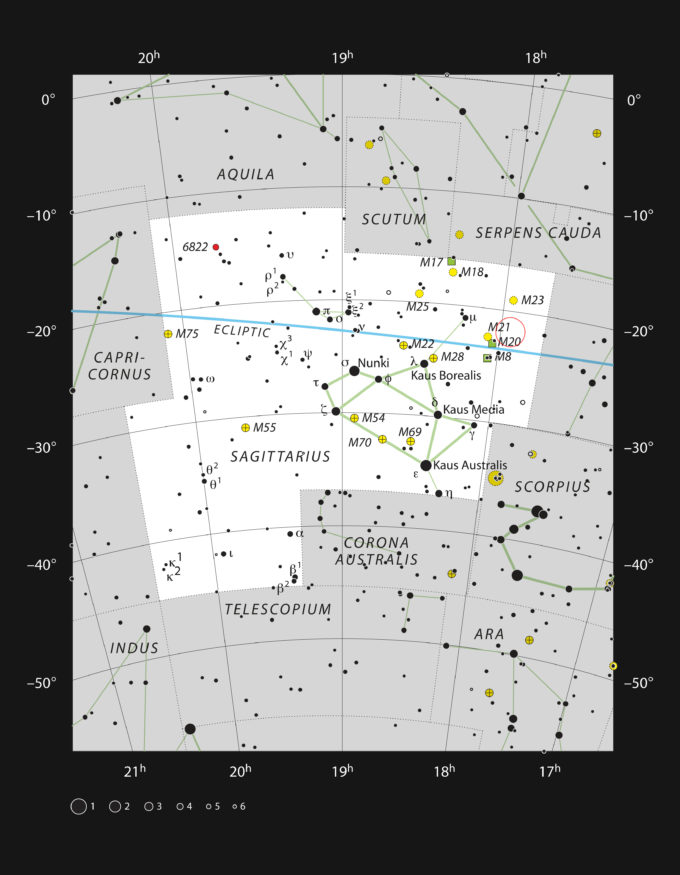
This chart shows the rich constellation of Sagittarius (The Archer) and marks the position of the star HD 163296. This star has a mass about twice that of the Sun, but is just four million years old. It is a little too faint to be seen with the unaided eye, but can easily be picked up with binoculars, not far from the famous Trifid Nebula and Lagoon Nebula. Credit: ESO, IAU and Sky & Telescope
To make their discoveries, each team analyzed ALMA observations of HD 163296, a young star about 330 light-years from Earth in the constellation of Sagittarius (The Archer) [3]. This star is about twice the mass of the Sun but is just four million years old — only a thousandth of the age of the Sun.
“We looked at the localized, small-scale motion of gas in the star’s protoplanetary disc. This entirely new approach could uncover some of the youngest planets in our galaxy, all thanks to the high-resolution images from ALMA,” said Richard Teague, an astronomer at the University of Michigan and principal author on the other paper.
Rather than focusing on the dust within the disc, which was imaged in earlier ALMA observations, the astronomers instead studied carbon monoxide (CO) gas spread throughout the disc. Molecules of CO emit a unique millimeter-wavelength light that ALMA can observe in great detail. Subtle changes in the wavelength of this light due to the Doppler effect reveal the motions of the gas in the disc.
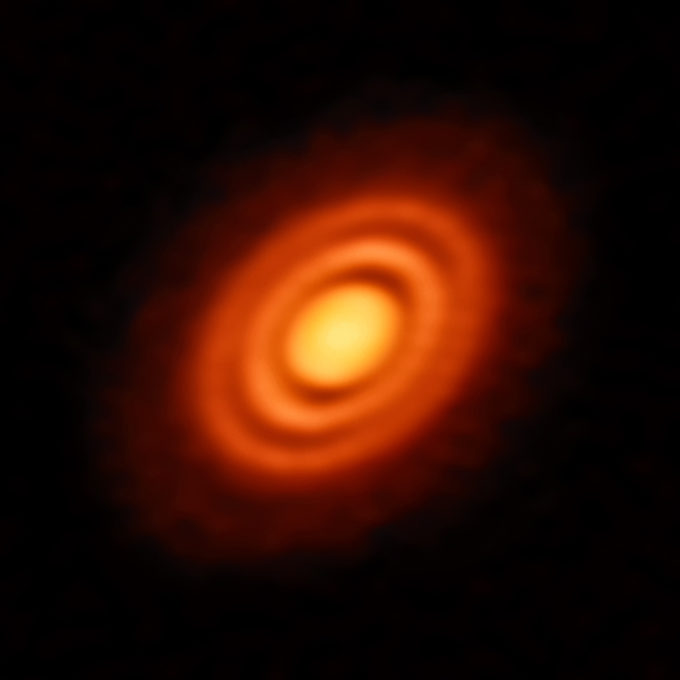
The gaps between the rings are likely due to a depletion of dust and in the middle and outer gaps astronomers also found a lower level of gas. The depletion of both dust and gas suggests the presence of newly formed planets, each around the mass of Saturn, carving out these gaps on their brand new orbits. Credit: ESO, ALMA (ESO/NAOJ/NRAO); A. Isella; B. Saxton (NRAO/AUI/NSF).
The team led by Teague identified two planets located approximately 14.9 billion and 24.7 billion kilometers from the star. The other group, led by Pinte, identified a planet at about 39 billion kilometers from the HD 163296 [4].
The two teams used variations on the same technique, which looks for anomalies in the flow of gas — as evidenced by the shifting wavelengths of the CO emission — that indicate the gas is interacting with a massive object [5].
The technique used by Teague, which derived averaged variations in the flow of the gas as small as a few percents, revealed the impact of multiple planets on the gas motions nearer to the star. The technique used by Pinte [6], which more directly measured the flow of the gas, is better suited to studying the outer portion of the disc. It allowed the authors to locate the third planet more accurately but restricted to more substantial deviations of the flow, higher than about 10%.
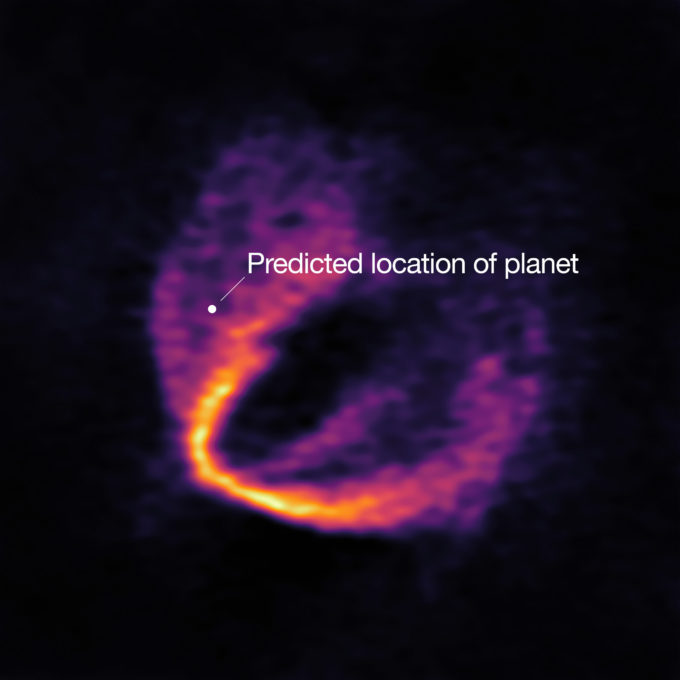
This image shows part of the ALMA data set at one wavelength and reveals a clear “kink” in the material, which indicates unambiguously the presence of one of the planets. The annotation shows the predicted position of the planet in question. Credit: ESO, ALMA (ESO/NAOJ/NRAO); Pinte et al.
In both cases, the researchers identified areas where the flow of the gas did not match its surroundings — a bit like eddies around a rock in a river. By carefully analyzing this motion, they could see the influence of planetary bodies similar in mass to Jupiter.
“The precision is mind-boggling,” said coauthor Til Birnstiel of the University Observatory of Munich. In a system where gas rotates at about 5 kilometers per second, ALMA detected velocity changes as small as a few meters per second. “This allows us to find very small deviations from the expected normal rotation in a disk,” Teague said. Planets change the density of the gas near their orbits, which varies the gas’s pressure, inducing these corresponding changes in velocity.
This new technique allows astronomers to estimate protoplanetary masses more precisely and is less likely to produce false positives. “We are now bringing ALMA front and center into the realm of planet detection,” said coauthor Ted Bergin of the University of Michigan.
“Often in science, ideas turn out not to work, or assumptions turn out to be wrong. This is one of the cases where the results are much more exciting than what I had imagined,” Birnstiel said.
Both teams will continue refining this method and will apply it to other discs, where they hope to understand better how atmospheres formation and which elements and molecules are delivered to a planet at its birth.
Zooming in on the young star HD 163296 from ALMA Observatory on Vimeo.
Notes
[1] Although thousands of exoplanets have been discovered in the last two decades, detecting protoplanets remain at the cutting edge of science and there have been no unambiguous detections before now. The techniques currently used for finding exoplanets in fully formed planetary systems — such as measuring the wobble of a star or the dimming of starlight due to a transiting planet — do not lend themselves to detecting protoplanets.
[2] The motion of gas around a star in the absence of planets has a straightforward, predictable pattern (Keplerian rotation) that is nearly impossible to alter both coherently and locally so that only the presence of a relatively massive object can create such disturbances.
[3] ALMA’s stunning images of HD 163296 and other similar systems have revealed intriguing patterns of concentric rings and gaps within protoplanetary discs. These gaps may be evidence that protoplanets are plowing the dust and gas away from their orbits, incorporating some of it into their atmospheres. A previous study of this particular star’s disc shows that the gaps in the dust and gas overlap, suggesting that at least two planets have formed there.
These initial observations, however, merely provided circumstantial evidence and could not be used to estimate the masses of the planets accurately.
[4] These correspond to 100, 165 and 260 times the distance from the Earth to the Sun.
[5] This technique is similar to the one that led to the discovery of the planet Neptune in the nineteenth century. In that case anomalies in the motion of the planet Uranus were traced to the gravitational effect of an unknown body, which was subsequently discovered visually in 1846 and found to be the eighth planet in the Solar System.
[6] The technique used by the Pinte team to determine the presence of the planet is based on a study entitled 'Planet formation signposts: observability of circumplanetary disks via gas kinematics’, by Perez et al., published in ApJL in 2015.
More information
This research was presented in two papers to appear in the same edition of the Astrophysical Journal Letters. The first is entitled “Kinematic evidence for an embedded protoplanet in a circumstellar disc,” by C. Pinte et al. and the second “A Kinematic Detection of Two Unseen Jupiter Mass Embedded Protoplanets,” by R. Teague et al.
The Pinte team is composed of: C. Pinte (Monash University, Clayton, Victoria, Australia; Univ. Grenoble Alpes, CNRS, IPAG, Grenoble, France), D. J. Price (Monash University, Clayton, Victoria, Australia), F. Ménard (Univ. Grenoble Alpes, CNRS, IPAG, Grenoble, France), G. Duchêne (University of California, Berkeley California, USA; Univ. Grenoble Alpes, CNRS, IPAG, Grenoble, France), W.R.F. Dent (Joint ALMA Observatory, Santiago, Chile), T. Hill (Joint ALMA Observatory, Santiago, Chile), I. de Gregorio-Monsalvo (Joint ALMA Observatory, Santiago, Chile), A. Hales (Joint ALMA Observatory, Santiago, Chile; National Radio Astronomy Observatory, Charlottesville, Virginia, USA) and D. Mentiplay (Monash University, Clayton, Victoria, Australia).
The Teague team is composed of: Richard D. Teague (University of Michigan, Ann Arbor, Michigan, USA), Jaehan Bae (Department of Terrestrial Magnetism, Carnegie Institution for Science, Washington, DC, USA), Edwin A. Bergin (University of Michigan, Ann Arbor, Michigan, USA), Tilman Birnstiel (University Observatory, Ludwig-Maximilians-Universität München, Munich, Germany) and Daniel Foreman- Mackey (Center for Computational Astrophysics, Flatiron Institute, New York, USA).
The Atacama Large Millimeter/submillimeter Array (ALMA), an international astronomy facility, is a partnership of the European Organisation for Astronomical Research in the Southern Hemisphere (ESO), the U.S. National Science Foundation (NSF) and the National Institutes of Natural Sciences (NINS) of Japan in cooperation with the Republic of Chile. ALMA is funded by ESO on behalf of its Member States, by NSF in cooperation with the National Research Council of Canada (NRC) and the Ministry of Science and Technology (MOST) in Taiwan and by NINS in cooperation with the Academia Sinica (AS) in Taiwan and the Korea Astronomy and Space Science Institute (KASI).
ALMA construction and operations are led by ESO on behalf of its Member States; by the National Radio Astronomy Observatory (NRAO), managed by Associated Universities, Inc. (AUI), on behalf of North America; and by the National Astronomical Observatory of Japan (NAOJ) on behalf of East Asia. The Joint ALMA Observatory (JAO) provides the unified leadership and management of the construction, commissioning and operation of ALMA.
Contacts
-
Nicolás Lira
Education and Public Outreach Coordinator
Joint ALMA Observatory, Santiago - Chile
Phone: +56 2 2467 6519
Cel: +56 9 9445 7726
Email: [email protected]
-
Christophe Pinte
-
Richard Teague
-
Calum Turner
ESO Assistant Public Information Officer
Garching bei München, Germany
Phone: +49 89 3200 6655
Email: [email protected]
-
Charles E. Blue
Public Information Officer
National Radio Astronomy Observatory Charlottesville, Virginia - USA
Phone: +1 434 296 0314
Cel: +1 202 236 6324
Email: [email protected]
-
Masaaki Hiramatsu
Education and Public Outreach Officer, NAOJ Chile
Observatory, Tokyo - Japan
Phone: +81 422 34 3630
Email: [email protected]

